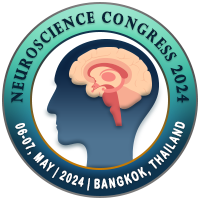
Barbara Rayne Santos de Alencar
Brazilian Academy Of Neurosurgery, BrazilTitle: Spinal Cord Stimulator: an integrative review of its neurophysiology, the diffusion of its use and effectiveness in the management
Abstract
It's well known that the spinal cord stimulator (SCS) is historically reported as a alternative non-opioid treatment for refractory chronic pain, through the stimulation of specific nerve fibers, A-beta, and the inhibition of painful impulses driven by the C-fibers and A-delta fibers, which is accordingly with the Gate Control Theory of Pain, by Melzack and Wall.
At the moment, there are different ways of stimulation, such as the traditional one, based on generating symptoms of paresthesia (P-SCS), Burst SCS and High Frequency SCS, which are new paradigms of stimulation without paresthesia (PF-SCS). As to Burst SCS, high frequency pulses are grouped in fast patterns, in blast, imitating the natural patterns of firing of neurons: it is conjectured by the author that it works as “accelerator/brake” system, wich means, while some neurons are busy transmitting signals in a tonic and continuous (speeding up) way, other neurons would be focused in retransmitting their information about the stimuli, happening in a parallel and progressive manner, in which, when arriving at the thalamus, all neurons became able to respond to a certain excitatory stimulus, whether it is in a tonic mode of classical stimulation or in the explosion mode. Both in the cortex and the hippocampus, it was also observed as a response to the explosive activity.
Furthermore, the present study gathers evidence of efficacy of the SCS in Complex Regional Pain Syndrome (CRPS), Refractory Angina Pectoris (APR), Failed Back Surgery Syndrome (FBSS), Painful Diabetic Neuropathy (PDN) and Critical Lower Limb Ischemia (CLLI). In clinical studies, SCS showed significant pain relief and improvement in the patient's quality of life.
Biography
Barbara Alencar is a 24-year-old student in the 6th year of medical school in Recife-PE, Brazil. She ranked first overall in the entrance exam and received a full scholarship for half of the course. She attended a public school (Colégio Militar do Recife) through an admission competition and was recognized as an academic member of the Legion of Honor and a second lieutenant cadet. Barbara won a silver medal in the Brazilian Astronomy Olympiad and even participated in international qualifiers. She also achieved admissions to military institutions such as AFA, EFOMM, ESPCEX, and IME-RJ. Currently, Barbara is an aspiring research member of the Brazilian Academy of Neurosurgery (ABNc). She serves as the director of the Neurosurgery Academic League at Uninassau, LANEC, and works as a monitor in Applied Medical Radiology at the same institution, focusing on Cranial Radiology. Driving by her passion for scientific research, Barbara engaged in scientific initiation programs and published in the field of Brazilian Public Health, often as the lead author, with most of the publications being 100% original and without a medical/professor advisor. She was recently highlighted for her original literature review in the Brazilian Journal of Neurosurgery (JBNc), which she conducted independently.

